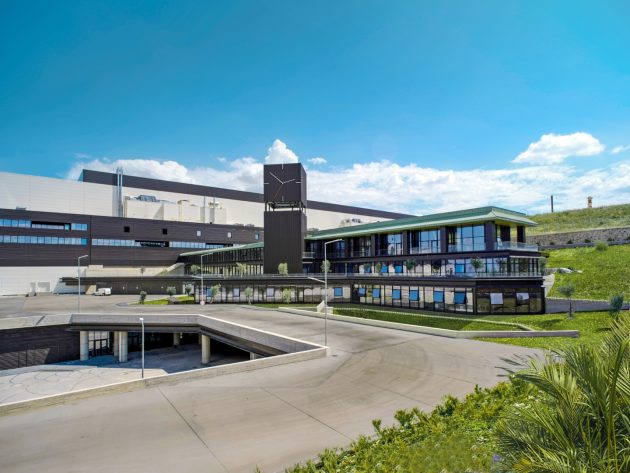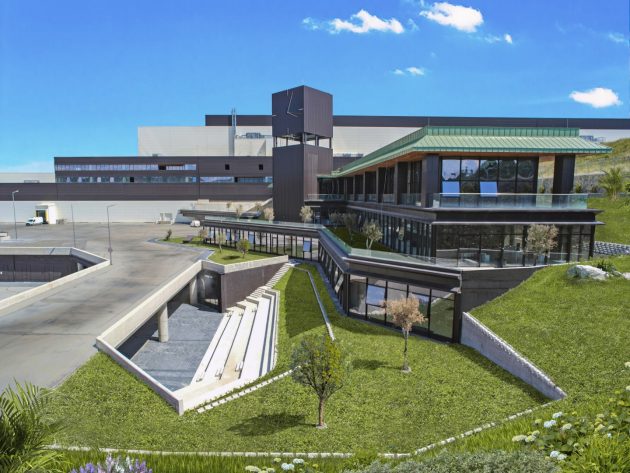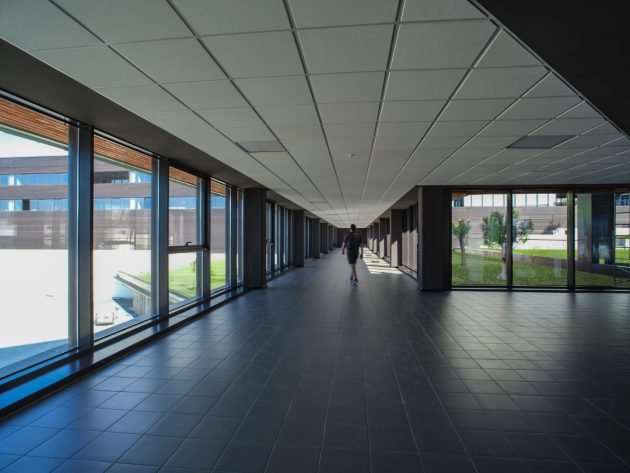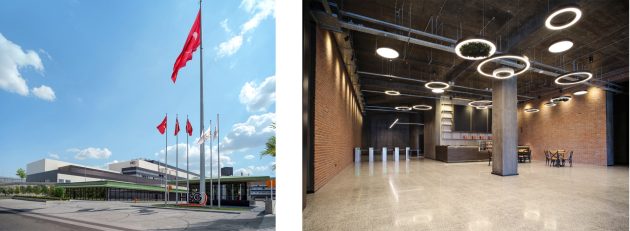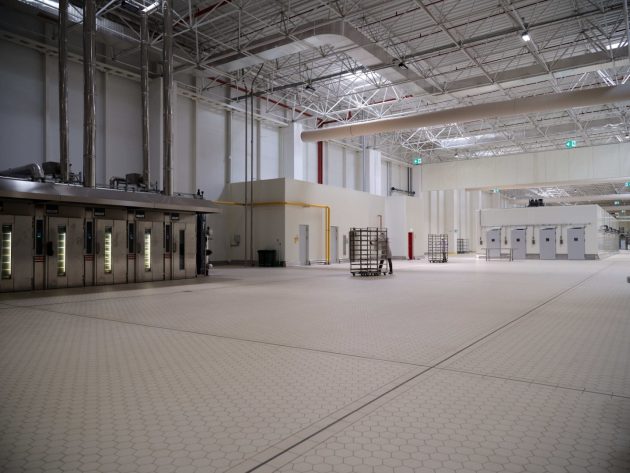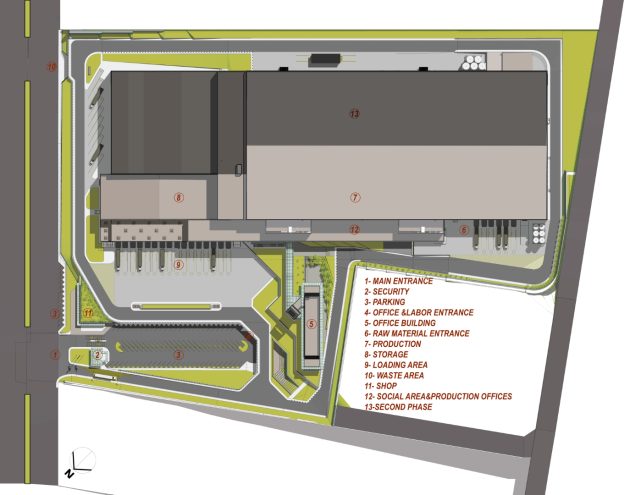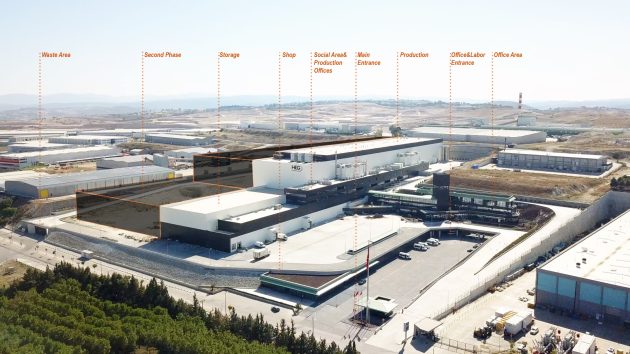Project: HEG GIDA Organic Products Production Campus
Architects: IGLO Architects
Location: Balikesir, Turkey
Area: 1,399,308 sf
Year: 2022
Photographs by: Fethi Izan
HEG Gıda Organic Products Production Campus were designed by Iglo Architects with an environmentalist approach to recycling, sustainability, and minimalizing carbon emissions without any vulnerability in the hygiene chain.
HEG Gıda Organic Products Production Campus, whose design process was carried out by the CO-founders of Iglo Architects, Architect Esen Akyar Karoğlu and Zafer Karoğlu, the manufacturing and management facility with a closed area of 130,000 sqm, built on a land of 85,000 sqm. The 36-meter level difference between the two roads adjacent to the parcel allows for designing floors with entrances at their level. The wide maneuvering area includes administration, manufacturing, and logistics units in sets located on the elevations and the entrance square feature technical structures, the shop, and the main entrance.
Since food safety is a priority in the HEG Gıda Organic Products Production Campus, guests first enter the access area limited by the natural borders of the square designed as a car park and then reach the reception area to use different elevators and stairs reserved for guests, blue-collars, and office workers. The reception area was designed with a café concept in mind, furthering its informatory function to allow the daily baked fresh goods to be served to the waiting guests and at the meeting rooms. Connecting to the manufacturing unit through a bridge, the clock tower functions as the distribution shaft of the building and is used to guide the blue-collar staff.
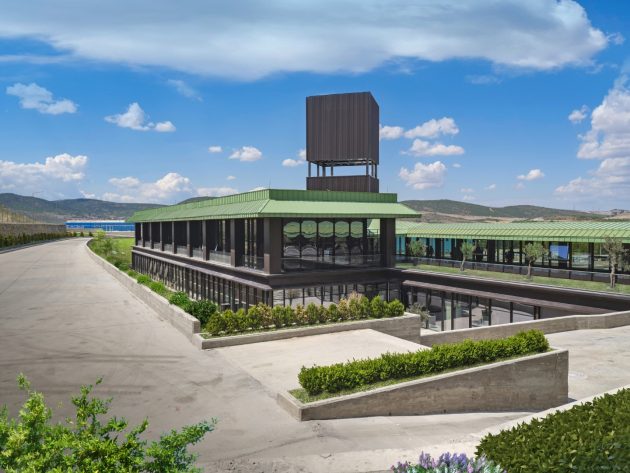
People can only enter the building after passing through a changing room where they wear sterile and hygienic clothes to ensure that there is no vulnerability in the hygiene chain. Once they enter this part of the building where they can use manufacturing offices and dining and social spaces, they have to go through the same process of sterilization and changing clothes to enter the manufacturing areas on the relevant floors. The ceiling, floor, and wall joints were built using materials of high fire safety standards, suitable for washing and allowing no dust, dirt, and bacteria. Intermediate floors were built on the manufacturing floors for all electrical, mechanical, and process lines to create hygienic spaces, thus ensuring no elements such as cables and conduits that would accumulate dirt are used in main halls. The ventilation channels passing through the hall are made of special washable textile materials.
Except for the oven hall on the last floor, all manufacturing areas are designed like giant refrigerators with air conditioning set to +4 °C, -15 °C, -25 °C and -45 °C. The products manufactured on the floors are prepared for shipment once sent to the storage system featuring 4.0 technology through conveyors.
The administrative building has been designed to have a view of the broad Balıkesir Plain, campus entrance, and shipping areas and to ensure each office unit has a direct connection to the gardens on the floors.
Sustainability was one of the most important inputs in planning. The entire operational process was planned with solutions that will cause no energy loss and waste. The organic wastes resulting from the processes were recycled through composting. The energy and heat generated while cooling and heating the system are reused with almost no loss.
The project is planned to include a technical-focused floor where R&D activities will be carried out together with universities to develop mechanical and technological tools that will increase the productivity of crops of agricultural products used as raw materials. The project aims to put the developed tools to use in the contracted fields to ensure organic safety, agricultural efficiency, and product quality.
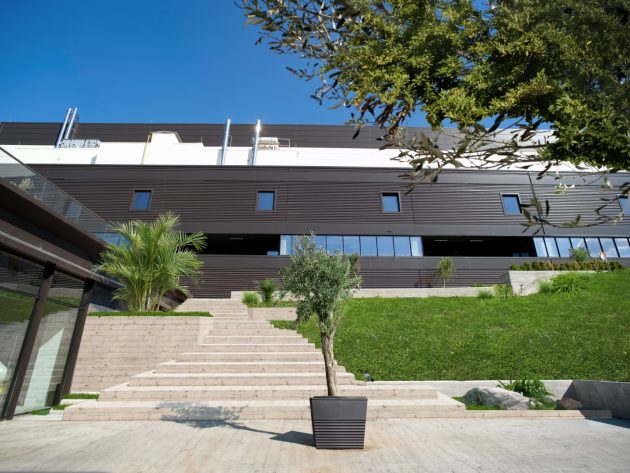
Different colors, materials, and textures were used on the facades of the building shaped by the process principles, workflow, and land elevations and featuring an administrative structure, controlled squares, and social areas located having their dominance over the area in mind. The green spaces created in areas where plants were only allowed under strict control for food safety purposes have provided a softer ambiance to the industrial environment.
It was important to build a campus that would function in line with the vision of the company, which follows an organic manufacturing approach. So, the structure was built in accordance with the requirements for obtaining the DGNB German green building certificate.
The aim was to create a business model that has an environmentalist approach to recycling and sustainability and focuses on minimalizing carbon emissions, which will become a role model in Turkey and worldwide.
Although it is a gigantic building with an almost twice large closed area of its land, the architectural design process followed principles of designing a building that would feature large empty spaces, not be too overwhelming from a human perspective, and be in harmony with its surroundings. The project was designed with special care to ensure efficient use of daylight and feature balconies, terraces, and gardens to allow people to take fresh air. The technical support areas necessary for the mechanical and electrical infrastructure and generator needs were placed under the truck maneuvering area to allow for direct intervention on the same floor. Located in the middle of the shop and reception areas and featuring a linear facade of grilles, these areas shape the structure of the lower square.
The waste rooms with the garbage containers that allow the facility to reach waste collection service without the need to enter the facility were made accessible through garbage chutes and tunnels to prevent insect infestation and dirt formation in the area.
The roofs of the manufacturing buildings were designed to be equipped with photovoltaic panels to generate electricity. Since the management of the organized industrial zone where the building is located invested in wind energy, clean energy was purchased from them to meet the power need of the system.
The preferred systems in the process were the ones working with environmentally friendly carbon dioxide and ammonia gases. Oil separators were used to prevent environmental pollution. Natural gas use in the heating of tap and process waters was reduced by 80% as a result of combining the heat of the steam oven units and hot oil boilers.
The whole building was equipped with materials providing a high level of insulation, each painted especially with environmentally friendly paints produced with natural methods.
-Project description and images provided by pRchitect

